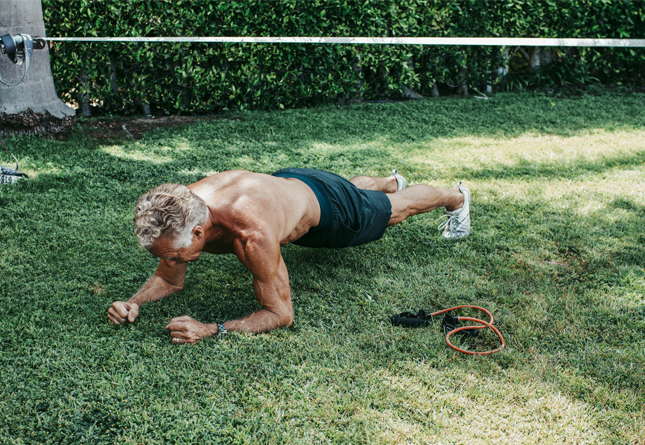
The core does not only exist to contract or bend over and over again, to twist and rotate, but also to resist rotational force. We need strong cores in order to maintain a stable torso while putting in work, whether it’s lifting heavy things, carrying a heavy load, or transferring power from our hips while throwing a punch or a ball. Having that stable, strong core with the capacity to resist the influence of outside forces working to make it rotate or twist or bend is just as important as having the capacity to perform a million situps.
Enter the plank. The key to success with it is right there in the name: you’re forming an immovable, stiff plank with your entire body. From toes to head, you must be firm, not flaccid.
Proper Plank Form
Planks seem like the simplest exercise imaginable, and while they aren’t that complicated, there are a few things to keep in mind.
- Get in the pushup position, only put your forearms on the ground instead of your hands. Your elbows should line up directly underneath your shoulders. Toes on the ground.
- Squeeze your glutes and tighten your abdominals. Imagine you’re pinching a quarter between your butt cheeks.
- Look at the ground to keep a neutral neck and spine. You may feel like your chin is tucked a bit.
- Tuck your pelvis. Instead of arching your back, do a slight pelvic tuck to really engage your abs. The pelvic tuck also allows you to use your quads and push against the ground with your feet.
- Push against the ground. Shoulder blades should protract.
- Create a straight, strong line from head to toes. A single cohesive piece. In other words, a plank.
- Hold that position.
What Muscles Do Planks Work?
The plank is a total body effort. When you’re in the plank position, every fiber of your being is resisting the pull of gravity. You must engage and tighten every inch of musculature in your body to resist collapse and maintain coherence throughout the line your body forms. During a plank, you are quite literally holding the line against the most omnipresent force in the known universe.
- Your abs are working to keep the spine from collapsing.
- Your glutes are contracting to support your lower back.
- Your erector spinae muscles are engaged to keep your spine cohesive and neutral.
- Your quads are contracting to stabilize your legs.
- Your hip flexors are activated to prevent your hips from breaking.
- Your serratus anterior is working to stabilize your shoulders.
And on and on and on. You’re placing your spinal column in the most disadvantageous position imaginable, exposed along every inch to the pull of gravity. You’re working everything during a plank.
Plank Benefits
Research shows that planks make you stronger, particularly in the trunk muscle. They can even increase the thickness of your abdominal muscles. In people who are fairly untrained, simply doing nothing but planks for a few weeks will increase their overall fitness levels. Not just trunk strength, that is, but general fitness.
Studies show that incorporating planks into the training of athletes can reduce injury rates by making their bodies more resilient. It turns out that having strong, stable trunk muscles makes you more resistant to all the various forces acting on you during athletic activity.
In short, planks are exercise, and exercise improves almost every health marker you can imagine. The thing about planks is that they appear to be a low intensity, easy exercise that most people never even consider doing. To the uninitiated, a plank might look like doing nothing at all.
Plank Variations
If you get bored of the traditional plank, there are other versions you can try.
Long Lever Plank
Instead of placing your elbows directly underneath your shoulders, place them several inches in front of your shoulders, thereby lengthening the lever and increasing the difficulty. Research shows that this increases activation of various trunk muscles. The more your elbows stray ahead of your shoulders, the harder it gets.
Side Plank
Do the plank on your side, supporting yourself with one hand placed on the ground and one edge of your foot wedged against the ground. Switch sides.
Contralateral Plank
Get in the traditional plank position, only support yourself contra laterally—either your left elbow and right foot touching or your right elbow and left foot touching.
Things to Remember
- Don’t let your hips sag down to the ground. Sagging hips makes the exercise initially easier, but it’s not a plank and it defeats the purpose of the exercise.
- Don’t look up! Look down at the ground. This is a good prompt for maintaining a neutral neck position.
- Don’t go to failure. When your form begins to suffer, pull the plug. You’re only benefiting from the plank by actually doing the plank with proper technique.
- Don’t overly arch your back. Keep that pelvis tucked.
Even if you never progress (or choose to progress) to the other plank variations, the basic plank, performed properly, will be sufficient for developing good core stability, strength, and overall resilience.
Got any more questions about planks? Drop them down below.
If you’d like to add an avatar to all of your comments click here!


